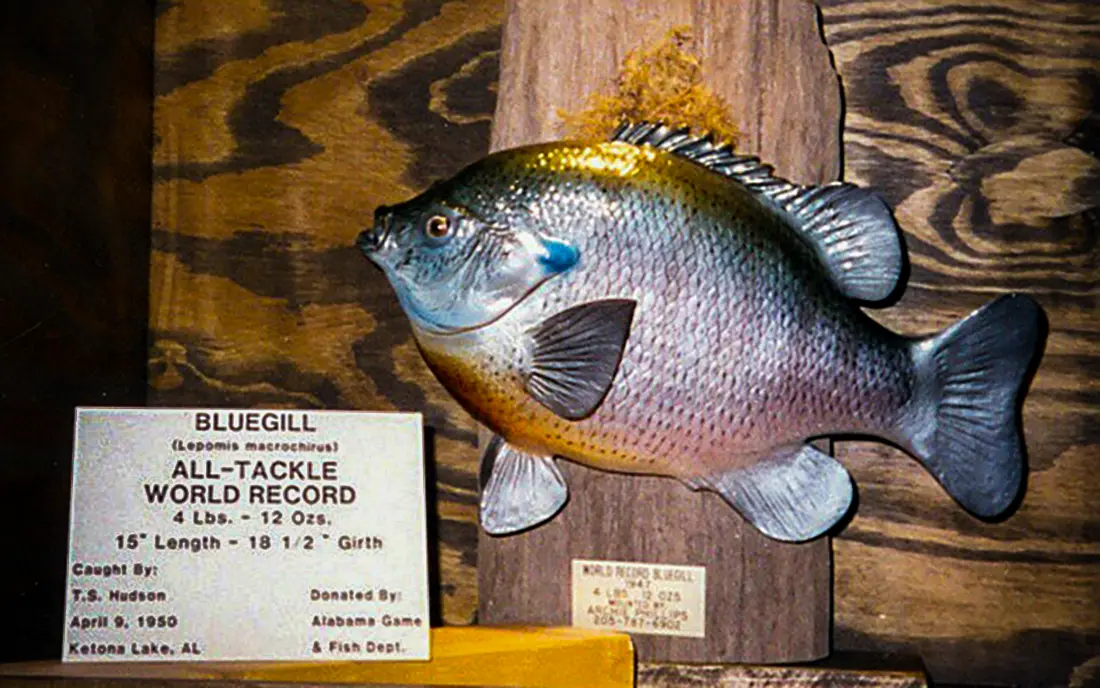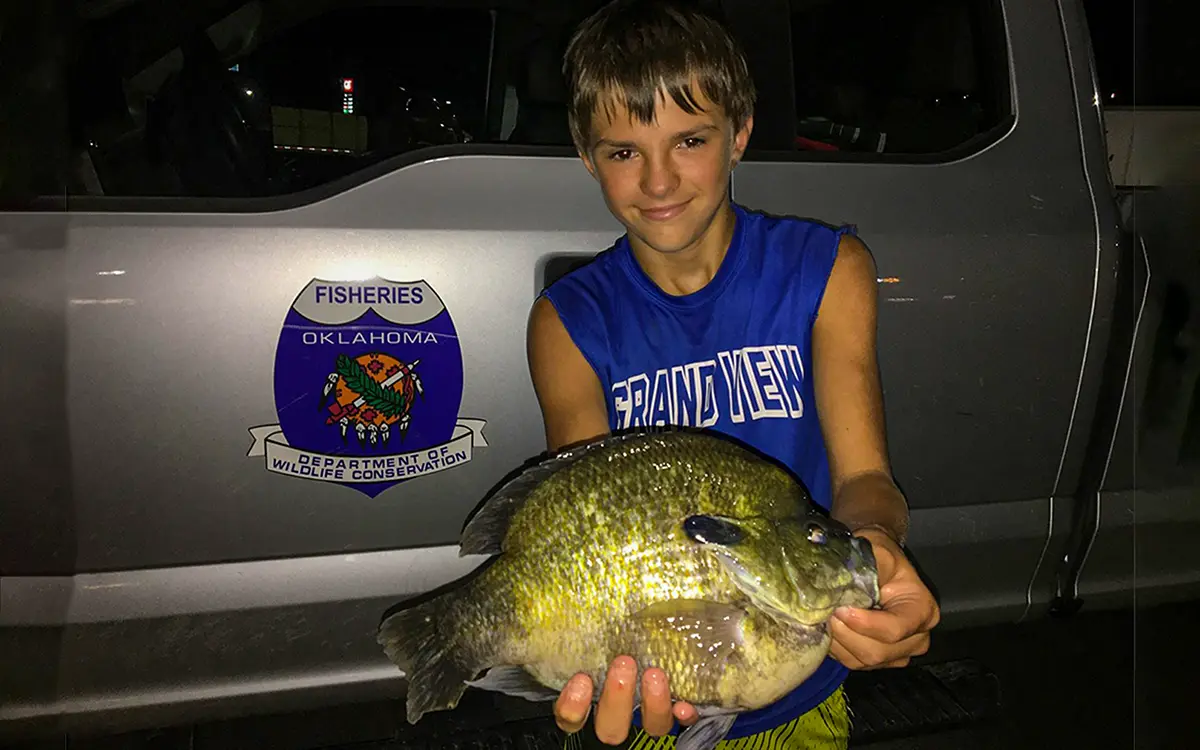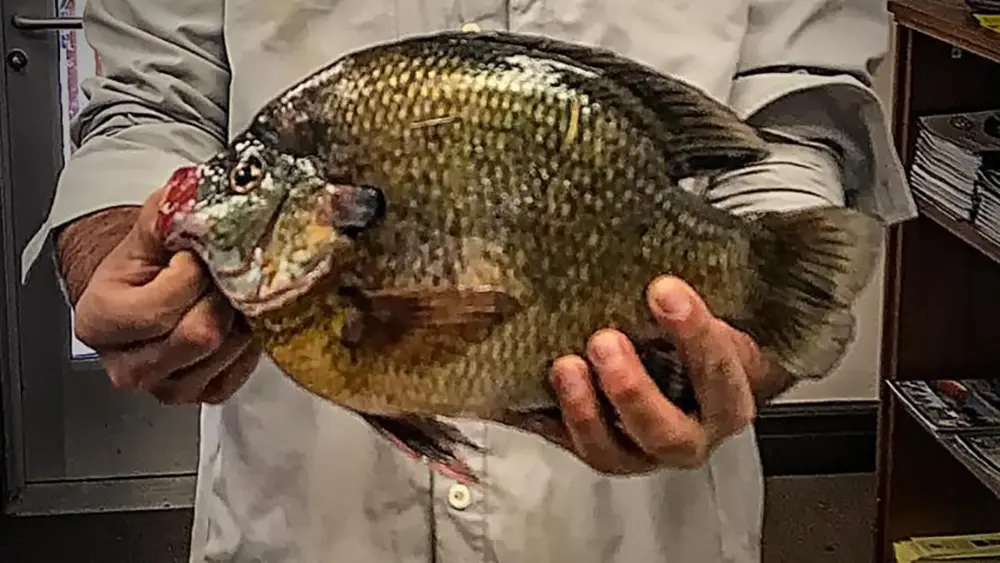Warning: Undefined variable $k in /home/nginx/domains/wired2fishcom.bigscoots-staging.com/public/wp-content/themes/understrap-child-0.6.0/functions.php on line 984
Warning: Undefined variable $k in /home/nginx/domains/wired2fishcom.bigscoots-staging.com/public/wp-content/themes/understrap-child-0.6.0/functions.php on line 987
Bluegills provide probably the most common fishing opportunities across the United States. They are found everywhere except Alaska, and you would be surprised to see what the state record is in your state. The largest bluegill ever caught weighed more than 4 pounds (in fact almost 5 pounds). Pound for pound, they are some of the hardest pulling fish in the lake for their size. If you’ve ever had a 10-inch bluegill or bigger on the line, you know these are awesome fights on ultralight gear.
The bigger bluegill have voracious appetites, can use their body to their advantage in a fight and are some of the best eating fish in the lake as well. So the benefits include plentiful dispersion, growth to solid sizes, provide lots of fun fishing for all ages and are great tasting table fare. What’s not to love about bluegill?
Many of us got our start bluegill fishing by watching a red worm getting eaten and a bobber getting pulled under by a hungry bluegill. But to chase the really big ones, you have to understand the species of bluegill. They can be caught on a variety of bluegill baits and lures and several different types of rods and setups. But there are certain methods and baits in common with the the record fish. And knowing how to catch bluegill can increase your odds of getting your own record bluegill.

The biggest bluegill ever caught
The tale of world record bluegill is really a tale of what was two world record bluegills out of the same lake in 3 years. In the late 1940s, it could be argued that the small strip mine lakes known as the Ketona Lakes in Alabama were the epicenter of the bluegill universe.
Located near Tarrant just north of Birmingham, these two small strip pits started as great sources of dolomite and limestone that was later used as flux to remove impurities from the steel that was big business in Birmingham at the time.
According to the locals at the time, a blasting gone wrong sprung a leak, a huge underground spring that filled both lakes rapidly. By the time the late 1940s rolled around, the lakes had become a hidden gem for trophy bluegills. The limestone made for an incredible breeding ground for big bluegills, but also made fishing there very tough because the gin clear water meant the fish could see you before you even got close to the water.
A local resident had figured out how to catch the big bluegills with regularity. Coke McKenzie worked at a nearby bolt and rivet company and would head to the lake after his shift and would regularly catch bluegills between 3/4 of a pound and 1 1/2 pounds. But on the fateful day in 1947, he snuck up to the waters edge on a very steep bank and extended his long cane pole over the water and let his unweighted ball of red worms sink to the bottom on his hook.
His quill float would tell him when a bluegill picked it up and when he saw it twitch, he set the hook. At first he thought there was no way it could be a bluegill as there were big bass in the lake but they were equally hard to catch.
When the fish surfaced, McKenzie knew it was the biggest bluegill he had ever seen. Because the sides were so steep there was no way to drag the fish up the bank and because the water was 10 feet deep, there was no one to get in to land them. Some nearby kids were gigging frogs. He borrowed their gig and gigged the biggest bluegill of his life and headed home with it in the dark.
“It’s a good thing I didn’t clean the fish,” McKenzie said in an interview with Louis Bignami. “It’s a good thing I didn’t clean the fish. We had company at the house, so I left it in the refrigerator in a pan of water. I planned on cleaning it in the morning, but the company stayed late, and I had to rush to work. We got to talking about the fish. The foreman and I got to arguing about its size. Then my boss heard how big it was. So he sent a man over to the house to get the fish. When the fish was weighed that afternoon it ran 4-pounds 10-ounces.”
Had he not gigged it and weighed it that night, he probably would still have the record today. The word, however, of his new world record “McKenzie Monster,” as it came to be known, spread, and anglers came trying their luck on the smaller of the Ketona Lakes.
In April of 1950, T.S Hudson, in the exact same fashion McKenzie had, crept up to the waters edge, extended a long cane pole and dropped his red worms into the water. And the rest, as they say, is history. His “Hudson Hawg” weighed 4 pounds, 12 ounces and set the new world record mark for bluegill.
Quick World Record Bluegill Stats
- Bluegill World Record Weight: 4 pounds, 12 ounces
- Bluegill World Record Length: 15 inches
- Bluegill World Record Girth: 18 1/4 inches
- Bluegill World Record Caught: 1950 on Ketona Lakes in Alabama
- Bluegill World Record Bait: Red worms, unweighted, cane pole

Other World Record Panfish
There are multiple types of bluegill and there are many other panfish that get confused with bluegill and are often misidentified sunfish. And because of this, some folks think the big red ears caught in Arizona are the bluegill records because several of them have been bigger than the 4-12 record for bluegill. But those are different panfish.
So here’s a quick rundown of the other Panfish World Records
- Red Ear Sunfish — 6 pounds, 4 ounces
- Pumpkinseed — 1 pound, 8 ounces
- Redbreast Sunfish — 1 pound, 12 ounces
- Longear Sunfish — 1 pound, 12 ounces
- Green Sunfish — 2 pounds, 2 ounces
- Warmouth — 2 pounds, 7 ounces
- Yellow Perch — 4 pounds, 3 ounces
- White Crappie — 5 pounds, 3 ounces
- Black Crappie —5 pounds, 7 ounces
- Rock Bass — 3 pounds

Likely Bluegill World Record States
There are several states that seem to have all of the ingredients to grow the biggest bluegills in the world. A handful of states have had bluegills over 4 pounds. Those states with 4 pound or better state record bluegill include Alabama, Kentucky, North Carolina, and Virginia and Arizona’s is a fraction of an ounce from being 4 pounds at 3 pounds, 15.69 ounces. Followed by California at 3 pounds 14 ounces.
And many believe Arizona is likely to produce the next bluegill record as it already has produced the record red ear sunfish. I think North Carolina and Alabama are prime breeding grounds for giant bluegills as is California. Surprisingly the Texas record bluegill is 2 pounds. So it’s not just about growing seasons but it’s also about forage base, water clarity and fertility and of course predation. If I had to guess, I would probably pick Arizona, or North Carolina. Because I’ve seen the bluegill fishing in those places. And the frequency of big bluegills.
There are also people working on private lakes trying to grow and raise some of the largest copper nose bluegill ever that could also end up bringing in the surprise world record.

State Record Bluegill Catches
Here is the run down of the state records for the biggest bluegills in every state save for Alaska. Minnesota has the oldest state record bluegill at 2 pounds, 13 ounces caught in 1948. Vermont has the most recent state record bluegill caught in 2020 at 2 pounds even.
| State |
Weight (Lbs Oz) |
Year |
Location |
| Alabama ** |
4 – 12 |
1950 |
Ketona Lakes |
| Arizona |
3 – 15 |
2004 |
Mapes Goldwater |
| Arkansas |
3 – 4 |
1998 |
Fulton County Pond |
| California |
3 – 14 |
2008 |
Rancho Murieta Res. |
| Colorado |
2 – 9 |
2019 |
Totten Res. |
| Connecticut |
2 – 4 |
1996 |
Pond |
| Delaware |
3 – 10 |
2001 |
Diamond Pond |
| Florida |
2 – 15 |
1989 |
Crystal Lake |
| Georgia |
3 – 5 |
1977 |
Shamrock Lake |
| Hawaii |
0 – 8 |
2000 |
Lake Wilson |
| Idaho |
3 – 8 |
1966 |
CJ Strike Res |
| Illinois |
3 – 8 |
1987 |
Pond |
| Indiana |
3 – 4 |
1972 |
Pond |
| Iowa |
3 – 2 |
1986 |
Pond |
| Kansas |
2 – 5 |
1962 |
Pond |
| Kentucky |
4 – 3 |
1980 |
Strip Mine |
| Louisiana |
1 – 10 |
1999 |
Pond |
| Maine |
0 – 8 |
2008 |
Pond |
| Maryland |
3 – 7 |
1998 |
Deep Creek Lake |
| Massachusetts |
2 – 1 |
1982 |
South Athol Pond |
| Michigan |
2 – 13 |
1983 |
Vaughn Lake |
| Minnesota |
2 – 13 |
1948 |
Alice Lake |
| Mississippi |
3 – 7 |
1995 |
Pond |
| Missouri |
3 – 0 |
1963 |
Pond |
| Montana |
2 – 10 |
1983 |
Peterson’s Stock Dam |
| Nebraska |
2 – 13 |
1977 |
Grove Lake |
| Nevada |
3 – 10 |
2010 |
Colorado River |
| New Hampshire |
2 – 1 |
1992 |
Goodwins Pond |
| New Jersey |
3 – 0 |
1990 |
Farm Pond |
| New Mexico |
3 – 2 |
1963 |
Lovington Lake |
| New York |
2 – 8 |
1992 |
Kohlbach Pond |
| North Carolina |
4 – 5 |
1967 |
Henderson Co. Lake |
| North Dakota |
2 – 12 |
1963 |
Strawberry Lake |
| Ohio |
3 – 4 |
1990 |
Salt Fork Lake |
| Oklahoma |
2 – 6 |
1987 |
Kay Co. Pond |
| Oregon |
2 – 5 |
1981 |
Pond |
| Pennsylvania |
2 – 9 |
1983 |
Keystone Lake |
| Rhode Island |
2 – 1 |
1987 |
Pond |
| South Carolina |
3 – 4 |
1973 |
Lancaster Co. Lake |
| South Dakota |
3 – 4 |
1980 |
Stanley Co. Dam |
| Tennessee |
3 – 0 |
1987, 1977 |
Pond, Fall Creek |
| Texas |
2 – 0 |
1999 |
Lampasas River |
| Utah |
2 – 7 |
1990 |
Mantua Res. |
| Vermont |
2 – 0 |
2020 |
Miller Pond |
| Virginia |
4 – 8 |
1970 |
Pond |
| Washington |
2 – 5 |
1984 |
Tampico Park |
| West Virginia |
2 – 12 |
1986 |
Pond |
| Wisconsin |
2 – 10 |
1995 |
Michigan |
| Wyoming |
2 – 15 |
2008 |
Pond |











